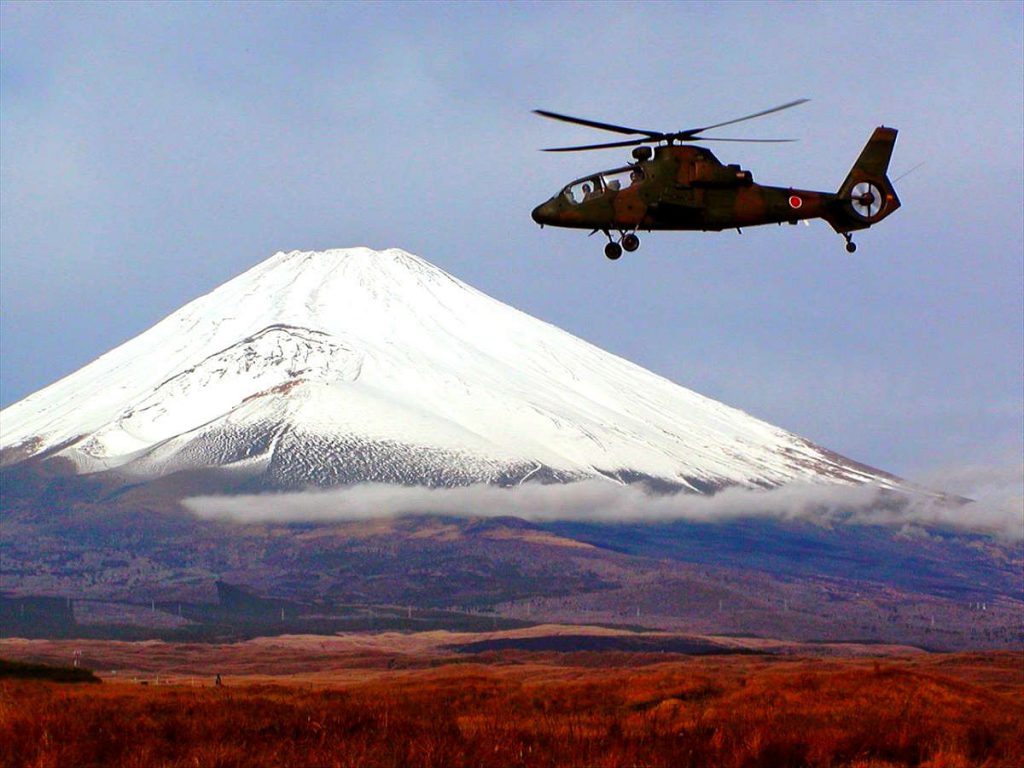Kawasaki OH-1 Ninja Attack Helicopter
Ever since the end of World War II, Japan has struggled to procure military-grade aircraft and equipment for its relatively small self-defense forces. Tasked with the impossible, guarding nearly 30,000 km of coastline with a force of 150,000 personnel, Japan depended upon technology from the United States to enable its helicopter defense fleet of accomplishing that goal. In 1996, the first OH-1 Ninja flew. But up until 2000, only 38 had actually been delivered to the fleet.
Domestic Design:
The Kawasaki OH-1 Ninja is novel in the sense that it is the first reconnaissance helicopter used by the Japanese Ground Self-Defense Forces made predominantly in Japan. Prior to that, the next capable attack helicopter was the Boeing AH-64 Apache. Japan ordered 50 Apaches but wanted to also have a fleet that it designed, built, and flew. The OH-1 Ninja appears to be that helicopter.

Airframe:
In terms of design and structure, the Japanese Ground Self-Defense Forces (JGSDF) appear to have used a very similar design as the Apache. The OH-1 Ninja is a very sleek, long helicopter powered by two twin Mitsubishi TS1-M-10 engines. It has four hard points which can be used to hold gun pods, rockets, anti-tank and anti-air missiles, or advanced sensor pods. The OH-1 Ninja is drastically underprepared for any direct combat role. However, its primary task is scout surveillance and reconnaissance. The helicopter can be launched from the back of a helicopter carrier or from a ground station. With a range of up to 342 miles, the OH-1 can effectively scout the coastline for littoral enemy vessels.

Questionable Upgrade:
When compared to its predecessor, the extremely light and nimble OH-6 Cayuse, the OH-1 Ninja is larger, bulkier, heavier, and not a marked improvement for combat viability. The OH-6 Cayuse appears very similar to the United States’ MH-6 Little Bird. This is an ideal choice for reconnaissance and scouting and, ironically, is still in use despite OH-1’s proposed plan to replace it.
Japan Left With No Viable Attack Helicopters:
Japan is only allowed to defend itself as per concessions made by Gen. Douglas MacArthur at the end of World War II. With its position so close to the interests of China, North Korea, Russia, and others, it has to either be completely dependent upon United States and NATO forces operating in the area or be left extremely vulnerable. However, it is increasingly apparent that Japan will be left vulnerable either way.

With the geopolitical climate heating up in the South China Sea, Japanese defense forces have a more aggressive role in order to protect its shipping and fishing fleet interests. This leaves it in the unfortunate position of not only trying to counter China’s aggressive developments on sea and air technology, but doing so with one hand tied behind its back.

Limited Deployment:
The current fleet of OH-1 Ninjas represent only a small fraction of the helicopter fleet used by Japanese Ground Self-Defense Forces. Its remaining fleet has no helicopters capable of any combat viability in open conflict with any current adversary that it shares a sea or ocean with. This may even include the Philippines, which has no organically built military air assets. This means that should the OH-1 Ninjas ever be required to exchange kinetic fire with enemy vessels or air assets, it wouldn’t be effective even for defense purposes.

AH-64 Apache Still Japan’s Top Defense Helicopter:
This may have been one reason that despite the initiative to build a Japanese fleet of helicopters, the Japanese still opted to purchase up to 50 Apache AH-64s. These highly modified military helicopters could at least assume a limited role in actually protecting the Japanese coastline until allies could arrive.
Though the event of open war with its neighbors is exceptionally limited, Japan has no real options for military power in the Pacific theater of operations. This means that when Russia tests its air defense grid with Su-27s, the best the Japanese can muster in response are the outdated and obsolete F-5s. The OH-1 Ninja is a great example of the right thinking — organically built military aircraft — applied incorrectly.
Powerplant:
The Kawasaki OH-1 Ninja was powered by either two Mitsubishi XT1-10 or TS1-M-10 engines. The TSI-M-10 engines were capable of up to 890 shp (660 kW) each.
See OH-1 Ninja Specifications
| Length: 39 feet 4 inches (12 m) |
| Height: 12 feet 6 inches (3.8 m) |
| Main Rotor Diameter: 38 feet 1 inches (11.6 m) |
| Maximum Take-Off Weight: 8,820 lbs. (4,000 kg) |
| Maximum Speed: 173 mph (278 km/h, 150 kn) |
| Range: 342 mi (550 km, 297 nmi) |
| Service Ceiling: 16,010 feet(4,880 m) |
| Crew: 2; 1 pilot and 1 observer |

